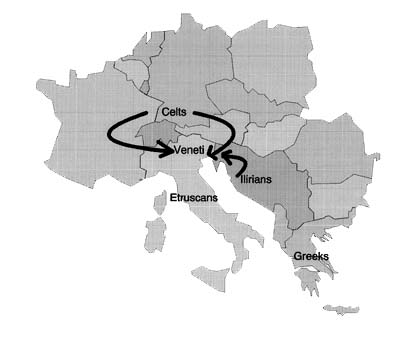| 3 | The Camillo Story |
The
Veneto
During the Bronze Age the Veneto region was populated by an Indoeuropean
people, different from the existing Italic population and from the Celts
that came from the North, beyond the Alps.
The
ancient Greek historian Herodotus of 490 B.C., considered the Veneti as
migrants to the area and refers to them as "Illiri", probably in
reference to their proximity to the neighbouring Illiria, the now
ex-Jugoslavia region. These people did in fact often invade the Veneto and
provided a constant menace, later dealt with by the Romans. However it is
evident that there undoubtedly was a certain amount of genetic
intermingling with these people.

According
to Livio, a Latin historian, born in Padua in 59 B.C. the leader of the
Veneti was supposed to have been Antenore, a Trojan hero, whose life was
spared after the fall of Troy at the hands of the Greeks and supposedly
led a group of followers to the Veneto and there founded the city of Padua.
Today there is in fact a monument in that city with the inscription:
"The Tomb of Antenore".
The
Veneti were basically agricultural but also renowned for their relatively
sophisticated technology for the production of glass ornaments that,
together with amber, were traded as far as Greece and Cyprus. As we have
seen, the position of the Veneto region was favourable for trade, which
certainly helped it prosper. They also traded with the neighbouring
Etruscan lands and to a certain extent, with the lands beyond the Alps,
where there was a certain predilection for wine. From this latter area
often came the invading Celts, a tall fair-haired, blue-eyed race, who
also certainly left a mark in the genetic heritage of the Veneti.
Not
much is known of the ancient Veneti, but we have some indirect indication.
Polibio states in the second century B.C., "the area close to the
Adriatic was inhabited by another, very ancient population, that of the
Veneti, whose customs and behaviour was little different to that of the
Celts, but with another language".
The
Celts were often described by ancient Roman scholars and by Julius Ceasar
himself who was given many a headache: a tall people with blond hair,
plastered with chalk to make it stand up, in order to create a frightening
aspect, "for they had a passion for war and were irascible, always
ready for a fight ... and ready to brave danger, armed only with their
strength and audacity."
Alexander
the Great, confident that his fame had reached far into the Celtic lands,
asked their ambassadors what they feared most and was dismayed with the
answer "The only thing we fear is that the sky should fall on our
heads."
A
Celtic tribe, the Boi, settled further south and founded the city of
Bononia, later known as Bologna, hence the origin of this city's name.
Another tribe, the Cenomani, settled in the Brescia - Verona area. These
tribes came down from the North, encouraged by the better climate, fertile
lands and particularly enticed by by olive oil, figs and wine. Plinio
makes a specific statement to this effect, giving it as the main reason
for the Celtic invasions of the city of Chiusi.
With
a close proximity of Celts to the West and to the South, there certainly
was much intermingling between the two peoples and a transmission of
physical and personality characteristics.
It
is interesting to note that the Celts spread to Normandy in France and to
the British Isles, where they remained genetically and linguistically
unaltered to the present day. At the turn of the last century, poverty
forced many to seek better fortune in Australia, bringing with them their
courageous and often boisterous ways. The noble fame of the Australian and
New Zealand soldiers (ANZACS) in the First World War, can probably be
attributed to their Celtic origins.
In
183 B.C. the Romans founded a colony in the Veneto territory, at Aquileia
and helped them against the attacks of the Celts, whom the Romans called
"Gauls". The Veneti thus slowly came under the influence of
Roman law and culture.
Because
of the Veneto's strategic geographical position, its mixture of mountains,
hills and plains, with an abundance of water and for its industrious
population, the Veneto prospered and its ports became busy and important,
laying the foundations for the future grandeur of its capitol, Venice.
Venice
was founded in the 6th century A.D., when the resident Veneto population
was forced to seek refuge in the many marshy islands of the large lagoon
in the area, in order to escape the constant invasions of the barbarians
from the north. Venice slowly grew and increased in power, widely
expanding its influence and culminating with the conquest of
Constantinople and the founding of the Latin Oriental Empire in 1204. Then
followed a century long battle for power with its rival on the Tirrenian
coast, world Genoa.
Return to Menu of Camillo Story
l-camillo.com
Copyright L. Camillo 2000